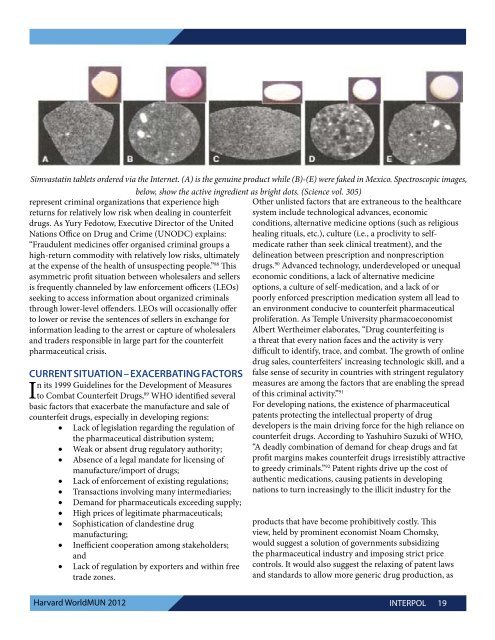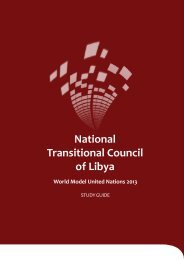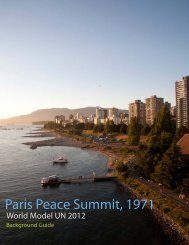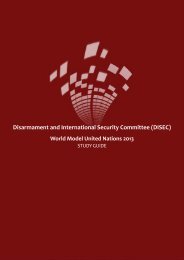INTERPOL - World Model United Nations
INTERPOL - World Model United Nations
INTERPOL - World Model United Nations
You also want an ePaper? Increase the reach of your titles
YUMPU automatically turns print PDFs into web optimized ePapers that Google loves.
Simvastatin tablets ordered via the Internet. (A) is the genuine product while (B)-(E) were faked in Mexico. Spectroscopic images,<br />
below, show the active ingredient as bright dots. (Science vol. 305)<br />
represent criminal organizations that experience high<br />
returns for relatively low risk when dealing in counterfeit<br />
drugs. As Yury Fedotow, Executive Director of the <strong>United</strong><br />
<strong>Nations</strong> Oce on Drug and Crime (UNODC) explains:<br />
“Fraudulent medicines oer organised criminal groups a<br />
high-return commodity with relatively low risks, ultimately<br />
at the expense of the health of unsuspecting people.” 88 is<br />
asymmetric prot situation between wholesalers and sellers<br />
is frequently channeled by law enforcement ocers (LEOs)<br />
seeking to access information about organized criminals<br />
through lower-level oenders. LEOs will occasionally oer<br />
to lower or revise the sentences of sellers in exchange for<br />
information leading to the arrest or capture of wholesalers<br />
and traders responsible in large part for the counterfeit<br />
pharmaceutical crisis.<br />
CURRENT SITUATION – EXACERBATING FACTORS<br />
In its 1999 Guidelines for the Development of Measures<br />
to Combat Counterfeit Drugs, 89 WHO identied several<br />
basic factors that exacerbate the manufacture and sale of<br />
counterfeit drugs, especially in developing regions:<br />
!" Lack of legislation regarding the regulation of<br />
the pharmaceutical distribution system;<br />
!" Weak or absent drug regulatory authority;<br />
!" Absence of a legal mandate for licensing of<br />
manufacture/import of drugs;<br />
!" Lack of enforcement of existing regulations;<br />
!" Transactions involving many intermediaries;<br />
!" Demand for pharmaceuticals exceeding supply;<br />
!" High prices of legitimate pharmaceuticals;<br />
!" Sophistication of clandestine drug<br />
manufacturing;<br />
!" Inecient cooperation among stakeholders;<br />
and<br />
!" Lack of regulation by exporters and within free<br />
trade zones.<br />
Other unlisted factors that are extraneous to the healthcare<br />
system include technological advances, economic<br />
conditions, alternative medicine options (such as religious<br />
healing rituals, etc.), culture (i.e., a proclivity to selfmedicate<br />
rather than seek clinical treatment), and the<br />
delineation between prescription and nonprescription<br />
drugs. 90 Advanced technology, underdeveloped or unequal<br />
economic conditions, a lack of alternative medicine<br />
options, a culture of self-medication, and a lack of or<br />
poorly enforced prescription medication system all lead to<br />
an environment conducive to counterfeit pharmaceutical<br />
proliferation. As Temple University pharmacoeconomist<br />
Albert Wertheimer elaborates, “Drug counterfeiting is<br />
a threat that every nation faces and the activity is very<br />
dicult to identify, trace, and combat. e growth of online<br />
drug sales, counterfeiters’ increasing technologic skill, and a<br />
false sense of security in countries with stringent regulatory<br />
measures are among the factors that are enabling the spread<br />
of this criminal activity.” 91<br />
For developing nations, the existence of pharmaceutical<br />
patents protecting the intellectual property of drug<br />
developers is the main driving force for the high reliance on<br />
counterfeit drugs. According to Yashuhiro Suzuki of WHO,<br />
“A deadly combination of demand for cheap drugs and fat<br />
prot margins makes counterfeit drugs irresistibly attractive<br />
to greedy criminals.” 92 Patent rights drive up the cost of<br />
authentic medications, causing patients in developing<br />
nations to turn increasingly to the illicit industry for the<br />
products that have become prohibitively costly. is<br />
view, held by prominent economist Noam Chomsky,<br />
would suggest a solution of governments subsidizing<br />
the pharmaceutical industry and imposing strict price<br />
controls. It would also suggest the relaxing of patent laws<br />
and standards to allow more generic drug production, as<br />
Harvard <strong>World</strong>MUN 2012 <strong>INTERPOL</strong> 19

















